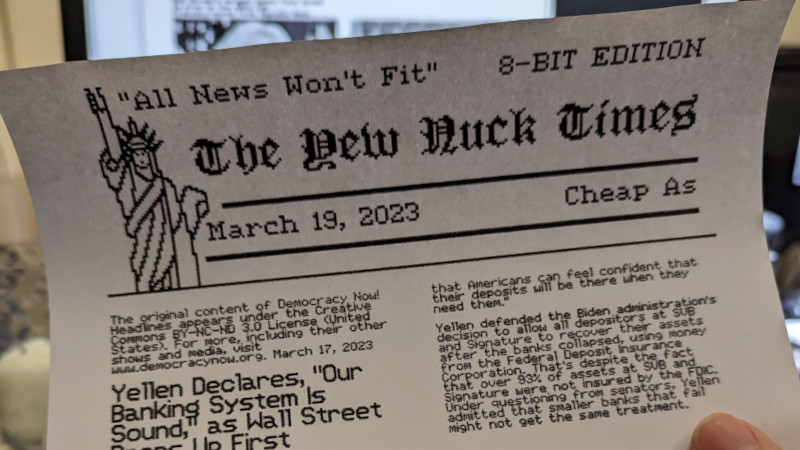In the late 80s and into the 90s, [Cameron Kaiser] aka [ClassicHasClass] was an aspiring journalist, first becoming interested in the career in elementary school and then working on various publications into university. At some point, he started using a piece of software for laying out newspapers called The Newsroom which, he admits, was lacking a lot of tools that would have been modern even for the time, but had an otherwise agreeable price tag thanks to its focus more on home desktop publishing and newsletter production than on full-scale newspaper operations. It did have one interesting feature that he never could figure out, though, at least until he went back and pieced this mystery together.
The software itself ran on the Apple II and was eventually ported to other systems of the era, including the Commodore 64. The mystery feature was known as “Wire Service” and appeared to be a way that users of the software who had a modem could connect with one another and share news releases, layouts, graphics, and other content created in Newsroom, but in the days where it would have been modern never was able to connect to anything. In fact, it was eventually abandoned by the developers themselves in later releases of the software. But [ClassicHasClass] was determined to get it working.
After doing a number of experiments to break down the ways that Wire Service sends information from one Newsroom instance to another, including sending fonts, pictures, and graphics, the next step was to create a modem for the Commodore to receive information. From there a news feed with the latest worldwide happenings can be created and sent to the antique machine. This did take a few tries to get all of the data sent and decoded correctly, but now a modern news feed can be generated, and even printed, with a distinct retro feel.
As far as retrocomputing goes, the Commdore machines are still wildly popular thanks to the ease that they can be modified. This was a design choice at the time they were produced which allowed them to use all kinds of other drives and peripherals, but is still useful now for things like this news service. It’s likely that you wouldn’t even need a hardwired modem to get this to work, either. Take a look at this build which adds a WiFi modem to an old Commodore.
















Looks like the First Bitcoin block:
“The Times 03/Jan/2009 Chancellor on brink of second bailout for banks”
https://en.bitcoin.it/wiki/Genesis_block
Cool to see this functionality in action. I wasnt’t aware of that function. Although, i have to admit, as a kid without a modem and just a crappy copy of the software itself my attention was more towards games on the other disks in my disk storage box. Nice writeup and fun project.
“The system runs almost entirely on trust.”
What about a World BankRun Day to verify that the system is resilient, as Mdme Yellen and Mdme Lagarde claim it is?
What about proof reading the articles before publishing ??
Which article, the article on this page (as written by Hackaday), or the article which this project is all about (the article written on the Commodore computer)?
I’m confused, who should be doing what, and what a bout proof reading the comments, whoever does that? Is it even needed, and why is there no way to edit a comment in case a tyypo is made?
Hey, good idea! A cheap Windows computer can do it, so let’s abandon everything else! I mean, what’s the point in retrocomputing in the first place?! All this stuff is easily accessible… even on modern low-end garbage. Learning is overrated… and don’t get me started on fun. Doing stuff because you derive pleasure from it?! What a pointless pursuit!
C64 is cooler than a craptop that can barely boot its own OS.
As much as I have an aversion against the stereotypical C64 fandom, I have to agree here. This article was really fascinating, showing the creative and intelligent side of C64 computing. Kudos. 😃👍
I love the Commodore 64. It was my first home computer! I used The Newsroom a lot back in the day, but never realized that there was a wire service. Perhaps I might have used this to send to my cousin who also created family newsletters.
What makes me wonder is why the software doesn’t seem to have a null-modem or acoustic coupler “mode”.
If it had one, an expensive modem (of the time) wouldn’t have had been required.
To implement this support, the software would only have had needed a manual connect option (call/answer), without requiring auto-dial and the acknowledge messages of a smartmodem.
I remember so many newsletters from those days looking just like this. Pretty cool.
What the heck is with the stories recently where they talk about the C=64 like it was just unearthed in a secret room in one of the pyramids?
It’s not THAT old nor THAT mysterious for crying out loud!
Eg. https://gamerant.com/gamer-commodore-64-works/
It turns 41 this year. That’s pretty old, as far as computers go.